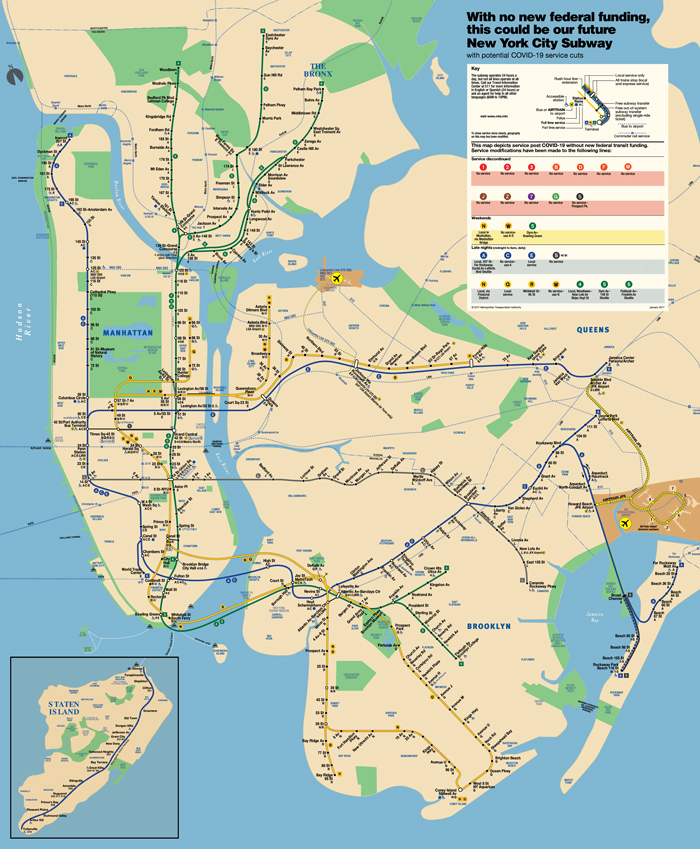Photo Courtesy of Riders Alliance
MTA’s possible Sophie’s Choice scenario: Eliminating every other subway line from New York’s system map.
By Michael V. Cusenza
Leadership at the Metropolitan Transportation Authority may soon face dire decisions and consequences if the agency doesn’t get more federal aid—and fast, according to a new analysis by the commuter-advocacy group Riders Alliance.
“Doomsday on the MTA” features graphic depictions of the wholesale destruction of public transit service that could hit the region next month if Congress doesn’t act.
According to the Alliance, because of pandemic-related losses and costs, the MTA needs $3.9 billion, roughly half its operating budget, to maintain operations through the end of 2020. Without a new federal cash infusion in the next month, devastating service cuts could isolate entire communities and threaten horrific overcrowding that would endanger commuters during COVID-19.
Here are the three scenarios that the MTA might have to choose from if the agency doesn’t receive federal aid soon:
- Agency Leaders Could Face A “Sophie’s Choice,” Eliminating Every Other Subway Line from New York’s System Map: In this scenario, half of the system’s trunk lines would be eliminated. The recent precedent of the much smaller 2010 cuts shows that eliminating lines entirely is a very real possibility. While it is impossible to know exactly which lines would be eliminated, this is one logical scenario. The result would be brutal, especially for end-of-the-line neighborhoods in the Bronx, Queens, and Brooklyn.
- Local Only Service: Essentially the MTA’s current overnight service plan, but with an across the board 50-percent frequency cut: Most rush hour subway trains would come every ten or 15 minutes and most off-peak trains two to three times per hour. Buses and commuter rail frequency would be cut proportionately so that lines would keep running but service would be dangerously crowded and delayed and also far less useful and dependable.
- Subway Only Service (plus Access-a-Ride): The subway is the MTA’s most popular and efficient service, moving more than half of all riders each day. In this scenario the MTA could shut down its commuter rail and bus lines, while leaving subway operations largely intact. Due to federal requirements, it would also need to operate Access-a-Ride paratransit for those unable to use the subway system, which is largely inaccessible and still requires climbing stairs to access most stations.
On Thursday, U.S. Sen. Kirsten Gillibrand (D-N.Y.) joined 24 colleagues in urging Senate leadership to provide an additional $32 billion in emergency supplemental funding for public transit agencies in the next COVID-19 stimulus package.
“This is an unprecedented time in our history and it requires strong, demonstrated leadership from this body, as well. We support an additional $32 billion in emergency aid to transit systems through the end of 2021 not only to keep these systems operational, but also to signal to our constituents that we will be ready for the economic recovery we are all working towards,” Gillibrand and her colleagues wrote to Senate Majority Leader Mitch McConnell and Senate Minority Leader Chuck Schumer.

